- Home
- Virginia Woolf
Mrs. Dalloway (Annotated) Page 5
Mrs. Dalloway (Annotated) Read online
Page 5
The parallels between these novels by Joyce and Woolf are probably best viewed as representative of formal and political concerns of their age. Both offer urban-centered novels that are confined in their actions to a single day, measuring out the commonplace actions of their characters against the elapsing hours. Both stroll their characters amid the commercial venues and political monuments of their respective cities, leaving the possibility for readers to infer rich cultural readings, particularly with the help of notes. Both enter the consciousness of their characters for extended periods and register variations in their energy levels and moods. Both make an unexpected switch from the character who seems to be central at the start of the novel to an outsider figure, establishing unusual connections that cross ethnicity, class, and age: Joyce’s disillusioned young artist, Stephen Dedalus, yielding prominence after three episodes to the middle-aged Jewish advertising canvasser and scientific amateur, Leopold Bloom; Woolf turning from her society matron, Mrs. Dalloway, to follow the intellectually aspiring Septimus Smith, who is of humble provincial origin and shell-shocked in war service. While Joyce’s characters eventually share actual experiences toward the end of the novel, Woolf’s have a final meeting only in Clarissa Dalloway’s mind. The mature characters in both novels flash back in time to the loves of their youth, testing the marriage plot, and the institution of marriage itself. There are smaller coincidences. Both books follow the route of an official vehicle traversing the city: Joyce’s showy viceregal procession surveying colonially administered Dublin; Woolf’s enclosed motorcar conveying a person of consequence—a prince or a prime minister—on some mission of importance. These displays demonstrate the appeal of spectacle and power to various people in the streets and invite the reader’s more satirical observations on imperialism and class difference. Shakespeare shadows both stories. Hamlet offers an important backdrop for Stephen Dedalus in Ulysses. The plays of Shakespeare both inspire Septimus Smith to go to war for England and, later, to suspect human character. The bidding of Shakespeare’s Cymbeline to “fear no more” runs through the minds of both of Woolf’s traumatized protagonists. Having shared some of the qualifications of his admiration for Joyce with Woolf, T. S. Eliot would eventually focus upon the mythic method of Ulysses, with its classical Homeric underpinnings, in his essay “Ulysses, Order and Myth.” Woolf’s reading of the Odyssey and Greek plays as she composed Mrs. Dalloway resulted in a less formal seepage of classical literature into her text, but it is a presence that has invited mythical interpretations for her work as well.
Increasingly, as Ulysses progresses, Joyce presents a different form for each episode, bringing us in “Oxen of the Sun” the styles of literature through the centuries, paralleling the stages of human gestation at the maternity hospital, or the hallucinatory dramas of the “Circe” brothel episode, or what he took to be the eternal feminine in Molly Bloom’s culminating “Penelope” monologue in bed. Unlike Joyce, with his well-demarcated episodes keyed to Homer’s text, Woolf doesn’t offer us chapter breaks but rather “very short intervals, not whole chapters” (Notes, October 6, 1922, in Wussow). In many of these intervals we encounter specialized discourses, some of them serving in her social critique. Going to lunch with Richard Dalloway, we find Hugh Whitbread crafting a persuasive political letter to the Times on behalf of Lady Bruton and a racist emigration scheme. Septimus and Rezia Smith hear the repressive voice of Proportion issuing from the mouth of the physician, Dr. Bradshaw. Septimus has hallucinatory episodes symptomatic of what we now call post-traumatic stress disorder, and Peter Walsh has a dream sequence, with a discourse of its own, while snoozing in the park. It remains a rewarding and almost inexhaustible exercise to both compare and contrast Ulysses and Mrs. Dalloway.
WOOLF WAS brought into the canon of modernism initially for her aesthetic and formal traits that most resembled Joyce, rather than the political departures that later made her appealing to feminist and postmodern critics. Earliest critics did feel challenged by her method, as her 1928 introduction suggests. They sought to achieve a sense of unity or balance between Woolf’s very different central characters, Clarissa and Septimus. Through the 1970s, critics focused upon Woolf’s experimental craft of fiction, a topic that has endured but also been reconstrued. Critics have continued to note patterns, such as Woolf’s strategic use of repetition and richly metaphoric language, applying these increasingly to cultural readings. There was also early interest in the psychology of the work, and Septimus’s recourse to suicide. The novel has encouraged spiritual readings that resurrect and negotiate ghosts and mythic figures from the past, to therapeutic effect. By the time deconstruction became a favored theoretical approach in the late 1970s, critics began to set less of a priority on unity, and favored more the various ways that Woolf challenged prevailing systems of order and masculine authority.
The 1980s brought a flourishing of feminist approaches to Woolf, beginning with her critique of patriarchy, and extending this focus into her biography, including her private accounts of her own treatments by physicians. By the 1990s the feminist interest in identities and sexualities found expression in lesbian studies, centering on Clarissa’s feelings for Sally Seton, and extending to Miss Kilman’s involvement with Elizabeth Dalloway, Septimus’s feeling for his lost commanding officer, Evans, and to a queering or skewing of representation. The ’90s also brought increased attention to ways that various systems of identification, including sexuality, class, and nation, interact with gender to produce a sense of self. Interest in global politics, and particularly the postcolonial critique of imperialism, emerged by the late ’90s. The concept of modernity, with its typical urban setting, its awareness of technology, commodification, and international capitalism, all are relevant to Woolf’s novel, which is frequently mentioned in illustrating modernity. Mrs. Dalloway has entered a new era of creative appropriation and popularization. It has been adapted for opera and film, and creatively reconceived for Michael Cunningham’s novel The Hours, which has been further adapted as a film, and for Robin Lippincott’s novella Mr. Dalloway. Despite its increasing remoteness in time, Mrs. Dalloway as well as other Woolf works like Orlando have moved with the times, proving applicable to enduring concerns.
Digging into Character and Politics
WE TAKE our first plunge into the caves Woolf described digging behind her characters with Mrs. Dalloway, her name conveniently supplied in the first two words of the novel. This moment occurs toward the start of a day that will culminate for many of its characters in Mrs. Dalloway’s party. The slightness of having a party as the culmination of a plot is in keeping with the liberation from traditional form Woolf had claimed for her generation in “Modern Fiction” (154). Woolf’s digging into an individual character proceeds with the play of the mind of each person she follows into an ordinary situation, calling up associations and memories—a process akin to psychoanalysis. The squeak of hinges on the door of her London home transports Mrs. Dalloway back to her childhood home at Bourton, where the French doors squeaked as she (when a girl of eighteen) thrust them open to plunge “into the open air” (3). But she also recalls falling into a solemn mood. The caves of characters have come together and surfaced at former moments, like this remembered one. At Bourton, more than twenty years ago, Peter Walsh appears with a critical remark, “Musing among the vegetables” (3), wanting to call attention to himself. He will reappear in the present, later on the same day in London, exposing both familiar and new sides of himself as he calls on Clarissa at her home in Westminster.
By tunneling back to Bourton, we get to the roots of Mrs. Dalloway, set in her home turf, in the company of her father and aunt, but most firmly bonded to her contemporaries. She is at the vulnerable age when marriage was the expectation for young women of her class. The marriage plot, a staple of novels of the eighteenth and nineteenth centuries, is secondary and in need of political excavation in Woolf’s modernist feminist novel. This excavation concentrates more on relationships not sanctified and
preserved, rather than on the Dalloway marriage, which has survived into the present. At Bourton we mine a rapturous moment for Clarissa in the garden, when she is kissed by Sally Seton, and a disastrous one, when Peter interrupts this scene. Peter has his own catastrophe, when he realizes that it is Richard, and not himself, whom Clarissa will wed. When Clarissa and Richard go off for an evening boating, Peter is left to interact with Clarissa’s aunt Helena, and we dig in yet another direction. Miss Parry’s botanical ventures, as a single woman of privilege in Burma, make her formidable. As we explore for her connections, we find that she joins with a large cast of characters who have made their way through empire, often uprooting more than orchids in the process. These figures include soldiers whose memorials line Whitehall, the ancestors of Lady Bruton, men sitting around in the Oriental Club, and, eventually, Peter himself.
When we visit Bourton in Peter’s memory, more of Clarissa is exposed. We find her prudish and chaste in her reaction to the affair between a neighboring squire and his housemaid that has produced a child—a moment Peter “tickets,” or labels, severely, as the “death of her soul” (58). Peter thinks of her father, Justin Parry, in a way that suggests that Peter is still contending with the patriarch who never liked the young men who wanted to marry his daughter. In a moment revelatory of buried trauma, Peter holds Parry responsible for the death of Clarissa’s sister, Sylvia, who was killed by a falling tree at Bourton. Peter’s meeting with Clarissa in London brings her confirmation of her father’s disdain for her suitors, but any trauma over Sylvia seems buried. Sylvia crosses her mind only in matter-of-fact ways. One has to wonder what Woolf must have felt in inventing this lost sister, given her very close connection to her surviving sister, Vanessa, and her loss of two half sisters, Laura Stephen (incarcerated in an institution for mental disability) and Stella Duckworth (who succumbed to peritonitis, perhaps complicated by early pregnancy). Clarissa also frustrates any curiosity about her parents. She thinks briefly of standing with her mother and father by the lake, feeding ducks, and is touched to tears when the elderly Mrs. Hilbery finds a resemblance between Clarissa and her mother, recollected walking in the garden’in a grey hat (171). Woolf’s more personal digging at parental roots would wait for To the Lighthouse.
Clarissa is the name that still resonates with Sally, Peter, and even Richard, but it has largely fallen from usage in her adult married life, as she deals with servants and merchants, in service of her domestic sphere, and entertaining colleagues of her husband. This suggested to early feminist critics that in marriage, Clarissa had relinquished a more feminine world, associated with the green world of the country (see Abel). This line of association of woman with nature has since been criticized as essentialist. Interestingly, we do not delve back to Bourton in any significant way through Richard’s character, though he has his own country affiliation with the county of Norfolk.
In London, in middle age, Mrs. Dalloway takes considerable pleasure in traversing the city. She continues to connect with others, and indeed makes a project of it with her party. We find that Miss Pym, the florist she has done business with for years, likes her and is thankful for some kind of help Clarissa has given her. There is a “concord” between Mrs. Dalloway and her maid, Lucy, who treats her umbrella like the “sacred weapon” of a goddess who has “acquitted herself honourably in the field of battle” (29). Clarissa is disappointed not to be asked to lunch by Lady Bruton. Instead we follow Richard to aristocratic Mayfair, where he serves Lady Bruton’s conservative political ends. He muses, helpfully for character construction: “She should have been a general of dragoons herself. And Richard would have served under her, cheerfully; he had the greatest respect for her; he cherished these romantic views about well-set-up old women of pedigree” (102). Lady Bruton thinks of Clarissa in relation to the analysis of character: “She had never seen the sense of cutting people up, as Clarissa Dalloway did—cutting them up and sticking them together again” (101); she saw little difference between men, at her age. Indeed, we see Clarissa better, thanks to this contrast.
One of the most intriguing connections Clarissa makes, however, is negative and deeply troubling—her reaction to Doris Kilman, the tutor whom she suspects (correctly) of trying to alienate her daughter Elizabeth’s affections. As noted above, Clarissa has herself experienced lesbian attraction to Sally Seton. Running naked through the hall at Bourton, bicycling around the parapet, making arrangements of floating flowers, and reading forbidden socialist texts, Sally is a far more attractive figure than Miss Kilman. Although she considers many other factors in analyzing her negative feelings, Clarissa does not address the lesbian potential of her daughter’s relationship. Clarissa is able to appreciate other differences with Miss Kilman. We discover the hostile climate faced by people of German nationality on the home front of World War I. Despite her training as a historian, Miss Kilman has been dismissed from her teaching position because of her nationality. She has found solace in religion, and by encouraging Elizabeth to pray, she seems to be working toward the girl’s religious conversion. Clarissa is sensitive to difference in class, though the evidence she focuses upon—matters of dress and grooming—suggest snobbery. “Year in year out she wore that coat; she perspired; she was never in the room five minutes without making you feel her superiority, your inferiority; how poor she was; how rich you were” (11).
Clarissa tries to manage her own hatred: “For it was not her one hated but the idea of her, which undoubtedly had gathered in to itself a great deal that was not Miss Kilman; had become one of those spectres with which one battles in the night; one of those spectres who stand astride us and suck up half our life-blood, dominators and tyrants” (12). There is then, in this idea, something that diminishes or even destroys life, touching at a major theme of the novel, and in Woolf’s sense of what fiction should be after, “life itself” (“Modern Fiction” 155). Woolf gives us the distinct impression that we have dug into a dark place in Clarissa’s psychology: “It rasped her, though, to have stirring about in her this brutal monster! to hear twigs cracking and feel hooves planted down in the depths of that leaf-encumbered forest, the soul” (12). We go with Miss Kilman and Elizabeth Dalloway to the Army and Navy Stores, but leave Miss Kilman there, a deliberate loose end, not neatly channeled into the culminating party.
“The Sane and the Insane Side by Side”
THE TUNNELING process can be pursued in this manner through many people in Clarissa Dalloway’s life, and those they touch upon. It functions somewhat differently, it seems, in the case of Septimus Smith. While working on Mrs. Dalloway, Woolf makes the perhaps dubious suggestion in her notebook (November 19, 1922, in Wussow) that he “might be left vague—as a mad person is—not so much character as an idea.” This presumed difference may have called for a modified method. Contact is limited. A 1999 film version of the novel brings Clarissa Dalloway and Septimus Smith into eye-to-eye contact, whereas Woolf merely places them in Bond Street, where they hear the same backfire from a car. Peter sees the Smiths in Regent’s Park, but fails to comprehend their situation. He may hear the siren of the actual ambulance that bears away Septimus’s remains, but rather than contemplate the tragedy, Peter goes off on a line of thought that glories in the modernity of the capital city he has just returned to from India. Peter fails to come close to Septimus, unless inadvertently to suggest to readers that he has been sacrificed to supposedly progressive postwar modernity.
The tunneling process may work best where we can compare the variant interpretations of characters who know something about each other. Only Lucrezia Smith knows her husband well enough to present him thoroughly, tunneling to the surface during the war, when they met in Italy, and bringing to light incidents of their marriage, experienced on outings and walks, which bear upon his increasingly alarming symptoms of shell shock. In a limited manner, Septimus can think back to their meeting, and his failure of feeling for Rezia, both then and in the present. He also had a failure of feeling at the death in war
of his commander, Evans. With Septimus providing only a few clues, Woolf leaves it to readers to excavate his homoerotic bond to Evans, and a related homophobic panic that led to his marriage. For Septimus, Woolf had to make parallel devices, rather than her tunneled connections, work.
One of the ways that Woolf enables us to see her characters side by side, politically and emotionally, is by allowing them to share images and ideas. Trees offer one of many parallel images. Walking through St. James’s Park, Clarissa makes a metaphor for her life as mist in conjunction with the trees: “being part, she was positive, of the trees at home; of the house there, ugly, rambling all to bits and pieces as it was; part of people she had never met; being laid out like a mist between the people she knew best, who lifted her on their branches as she had seen the trees lift the mist, but it spread ever so far, her life, herself” (9). Sitting in Regent’s Park, Septimus is excited by “the elm trees rising and falling, rising and falling with all their leaves alight and the colour thinning and thickening from blue to the green of a hollow wave” (21–22). Rezia only briefly brings him back to reality by placing her hand on his knee, or bidding him look at real things. By the time she has strolled briefly apart he is making proclamations, “Men must not cut down trees,” and hearing Greek words from birds singing from railings and trees, and sensing that Evans had returned (24).

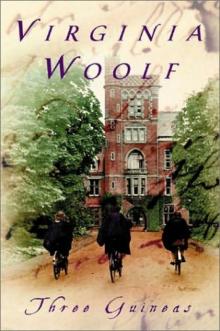 Three Guineas
Three Guineas Flush
Flush Mrs. Dalloway
Mrs. Dalloway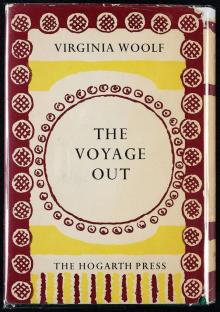 The Voyage Out
The Voyage Out A Writer's Diary: Being Extracts From the Diary of Virginia Woolf
A Writer's Diary: Being Extracts From the Diary of Virginia Woolf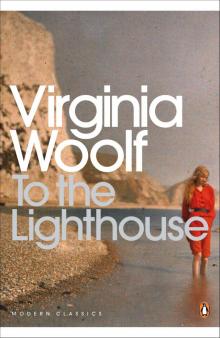 To The Lighthouse
To The Lighthouse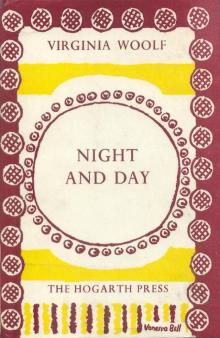 Night and Day
Night and Day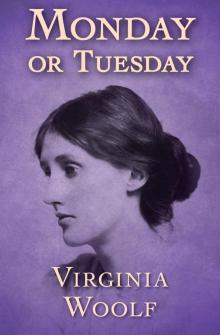 Monday or Tuesday
Monday or Tuesday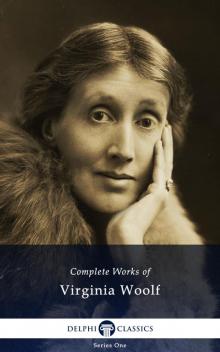 Complete Works of Virginia Woolf
Complete Works of Virginia Woolf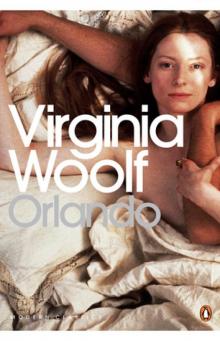 Orlando
Orlando Genius and Ink
Genius and Ink Mrs. Dalloway (Annotated)
Mrs. Dalloway (Annotated) Jacob's Room
Jacob's Room THE RUSSIAN POINT OF VIEW
THE RUSSIAN POINT OF VIEW A Writer's Diary
A Writer's Diary Woolf Short Stories
Woolf Short Stories